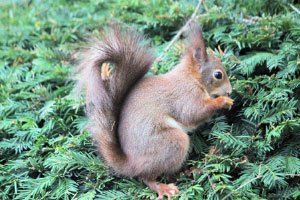5 ways to attract endangered red squirrels into your garden
The red squirrel population is rapidly declining, but if you're not ready to say goodbye to these beautiful creatures just yet, there are plenty of ways you can encourage them into your outdoor space. Here, Kathryn Eccles from pet supply specialist Millbry Hill, discusses how to attract red squirrels to your garden.
Red squirrels (Sciurus vulgaris) are hard to miss with their characteristic fiery red fur, bushy tail and large ear tufts. And, while these remain among one of our best-loved woodland animals, the reality is that the red squirrel population is depleting rapidly. In fact, Woodland Trust reports that since grey squirrels (Sciurus carolinensis) were introduced in the 1870s, the number of red squirrels has dropped from approximately 3.5m to between 120,000–160,000.
While these are now considered a highly endangered species in Great Britain and Ireland, there are still some ways you can attract red squirrels. Here, I will be sharing what we can do to help red squirrels and welcome them into our gardens.
Plant trees that they love
Red squirrels are under threat from grey squirrels who pass a fatal disease to the reds, so it's important that you consider which trees will welcome them while keeping the greys at bay. The main thing you'll want to do is to ensure there is a healthy food  supply that'll last all year round. This is specifically important to note as many tree species won't start producing seeds until they reach a certain age, so you'll need to be careful choosing which ones to plant.
supply that'll last all year round. This is specifically important to note as many tree species won't start producing seeds until they reach a certain age, so you'll need to be careful choosing which ones to plant.
Trees including brambles, crab apples, holly, yew and most species of conifer are great for inviting red squirrels into your garden, as are ash trees, birches and willows. Just make sure that there is a continuous space for the reds to move through, as this can make an attractive woodland for them.
To prevent interaction between red and grey squirrels, I'd advise avoiding oak and beech trees.
Put out feeding boxes
The red squirrel diet mainly consists of seeds and nuts, but they will also eat fruit, plant shoots, insects and fungi when the former isn't available. However, when they're constantly in competition with grey squirrels for food, it'll be a good idea to create a supplementary feeding box.
In this box, you could put shelled hazelnuts, linseed, pine nuts, sunflower seeds and apples and carrots. However, it's important that you're not overfeeding your garden visitors, so be sure to only put the box out every 3–4 days.
Attract insects for food sources
 Creating a wildlife haven in the corner of your garden can be great for welcoming all sorts of animals, but as it also attracts insects, it'll provide more opportunities for red squirrels to feed.
Creating a wildlife haven in the corner of your garden can be great for welcoming all sorts of animals, but as it also attracts insects, it'll provide more opportunities for red squirrels to feed.
To do this, you'll need to include plenty of rocks and logs which will encourage insects to the space for the reds to feed on. Similarly, it'll double up as a hiding place for the squirrels when predators are around. As well as welcoming insects, these spaces can also be great for promoting fungi growth — another great food source for reds.
Deter grey squirrels
Grey squirrels are much more common than red squirrels, but interaction between the two could deplete the red squirrel population even more. So, you'll need to deter greys from the red squirrel habitat that you've built.
Although you won't be able to monitor your garden all hours of the day, if you do happen to see grey squirrels crowding around your feeder, removing this will help to discourage them from coming back. However, make sure you disinfect it often and remove old food to prevent the spread of fatal diseases between red and grey squirrels.
Similarly, designing a habitat that isn't suitable for grey squirrels, will discourage them from coming to your garden. So, consider adding barriers, such as coniferous trees.
Report any sightings
If you do manage to attract a red squirrels, it'll be important to report these sightings to a local or national conservation trust like the Red Squirrel Survival Trust. They will then be able to advise you on the best ways to protect biodiversity and how to secure your garden environment to ensure the red squirrels are safe.
Help to preserve the endangered red squirrel species by providing them with a place to live and eat. Simply follow my top five tips and you may just get to see some beautiful wildlife in your garden soon.
- Log in to post comments

